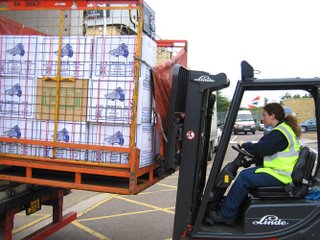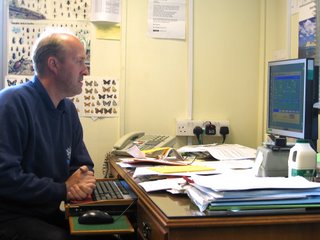Heathrow Animal Reception Centre (HARC)
People all the time are saying to me: "Always you are writing about the arts and the creative lives of people and sometimes you write semi-amusing haiku about cats or dinosaurs. Often we notice that you write an awful lot of things that are untrue and we fear for your moral and spiritual health. But what we want to know is why you don't write more about tropical fish."
Indeed, why don't I write more about tropical fish?
From this month's issue of "Practical Fishkeeping" magazine, the widest circulating publication for aquarium enthusiasts in Britain:
Heathrow Animal Reception Centre:
The UK's Ambassador To The World Ornamental Fish Trade
by
Neal Romanek
The UK's Ambassador To The World Ornamental Fish Trade
by
Neal Romanek
Unless your aquarium stock are restricted to animals bred and raised in the United Kingdom, the odds are near certain that they spent a few hours of their lives inside a warehouse on Beacon Road, just outside the southern boundary of Heathrow Airport at the Heathrow Animal Reception Centre (HARC).
 The Animal Reception Centre is the principle entry point for all live animals entering the United Kingdom by air. The Centre's mandate is to enforce the statutory requirements of UK and EU legislation with regard to importation of animals via air transport. This legislation incorporates Rabies Control – hence the Centre's previous designation as the Animal Quarantine Station - and the welfare of animals during transport.
The Animal Reception Centre is the principle entry point for all live animals entering the United Kingdom by air. The Centre's mandate is to enforce the statutory requirements of UK and EU legislation with regard to importation of animals via air transport. This legislation incorporates Rabies Control – hence the Centre's previous designation as the Animal Quarantine Station - and the welfare of animals during transport.The only other entry facilities in the EU of comparable scale to HARC are centres at the airports of Amsterdam and Frankfurt. The Amsterdam and Frankfurt centres tend to specialize in larger animals – horses and substantial mammals. Despite the fact that most of the invertebrates and fish in our aquaria pass through this surprisingly humble cluster of buildings, few are aware of HARC's importance to British fishkeeping, both as hobby and trade.
The City Of London's website observes that the Heathrow Animal Reception Centre receives all types of animals "from cats and dogs, to baby elephants, to reptiles and spiders." What they do not say is that in sheer numbers, volume, weight – just about any way you measure it – the bulk of livestock passing through their doors, and probably outweighing all the rest combined, is made up of fish and aquatic invertebrates.
It is difficult to appreciate the magnitude of the operation at the Centre until you observe it first-hand, as we did, escorted by HARC manager, Robert Quest. Lorry after lorry, chock-a-block with fully-loaded pallets, stands by to unload the shipments ferried over from the Heathrow terminals, each hauling a total volume of water and livestock that might fill a petrol truck. Mr. Quest explained that, on average, 35,000,000 fish pass through the Animal Reception Centre each year – sometimes fewer (in the slowest year on recent record, over 28,000,000 were admitted), sometimes many more.
Most flights carrying fish and aquatic invertebrates usually land on Mondays and Tuesdays. This is part of a shipping cycle that allows them to be transported throughout the UK and received by dealers during the week, to be ready for sale by the weekend.
The trucks begin arriving by nine in the morning. HARC forklift operators work at a steady pace emptying the trucks, shuttling their cargo into the "Fish Border Inspection Post", a long, green-painted warehouse across from HARC's main administrative building. In cold weather, ceiling-mounted heaters keep the temperature in the warehouse within an acceptable range until the shipments are cleared by the Centre's staff and ready to be picked up by domestic shippers.
Most fish cargo arrives on flights from Asia, the majority via Singapore. "Any flight that passes through Singapore on a Tuesday is going to have a belly hold full of fish," Quest said, "and the only thing that limits the number is the number of flights coming in." A single plane might contain up to 300 boxes of polystyrene fish containers. The next time you're on a long-haul trip from Asia and get hassled for being over the baggage weight limit, just tell yourself: "I'm doing it for the fish."
The biggest smuggling concern is the attempted importing of banned species – particularly corals. The Centre works in tandem CEFAS, the Centre for Environment, Fisheries & Aquaculture Science. CEFAS, an aquatic scientific research and consultancy centre, is an executive agency of DEFRA, the Department for Environment, Food, and Rural Affairs. CEFAS's stated purview is:
assessment and advice for managing and conserving fisheries, and for the conservation of marine and freshwater ecosystems environmental monitoring and assessment of nutrients, radionuclides, chemicals and other contaminants in the environment advice on aquaculture, disease control and hygiene of fish and shellfish incidents and emergency response service research and project management in support of the services above
The final phase of inspection is the physical check, conducted by the CEFAS animal health team. CEFAS inspectors open, and visually and physically inspect, 10% of the containers coming in. The condition of animals is assessed. Water samples are taken and tested for diseases and parasites.
The inspections are performed inside an enclosed room at one end of the Fish Border Inspection Post warehouse. The room features stainless steel countertops and deep stainless steel sinks and several heavy steel shelving units for storing heavy, water-filled containers. On one end of the room are rows of large, tapped tanks – like some massive cold drinks arrangement for a tremendous barbeque. These containers store both fresh and salt water. The facilities do not allow for the long-term housing of species, but the water stores – with the help of pure oxygen available – are sufficient to top up water and oxygen lost in the inspection, or to rescue animals that have fallen victim to shoddy packing or handling. As in a darkroom, an overhead red light is used for initial inspection of the fish, to avoid shock that a sudden flood of white light would cause. Once the fish pass this inspection procedure, clearance is faxed to HM Revenue & Customs in Salford who then declare the shipment ready to be transported.
 Despite the exhaustive checking, a shipment rarely spends more than four hours – more often closer to two - at the Centre before it is on a lorry and off to its destination.
Despite the exhaustive checking, a shipment rarely spends more than four hours – more often closer to two - at the Centre before it is on a lorry and off to its destination.Fish are banned entry into the UK for two reasons. Either the animals are endangered and the UK, or EU, is signatory to the legislation recognizing the animal's status. Or the animal poses a health risk for the indigenous ecosystem – either to naturally occurring animals and plants or to commercially bred species.
If there are banned animals in the shipment, the consignment is removed, and the banned animals – which have included freshwater crayfish, corals, and most recently seahorses – are destroyed
Of the fifty or so prosecutions a year by the Centre, Quest says that only a very few ever involve fish shipments. Most of the legal action the Centre had to employ has been against cases involving larger vertebrates – cats shipped in too-small carriers for example. In the case of the aquarium stock shipments, most prosecutions are due to improper handling and packing. "Fish disasters are usually because of massive delay somewhere, bad stowage – we had one consignment that got put on the hot water pipes in the aircraft, so the bottom layer was too hot to say the least –and then handling. And that's handling not so much on the aircraft but between the aircraft and here." In such cases it is the airline that gets prosecuted, since they are liable for the safety of the shipment.
Its easy to forget that HARC is an organization driven by legislation and not charity or science. This is nowhere more apparent than the definitions of coldwater fish vs. tropical fish, which have recently been adopted.
All ornamental fish imported are classified as either "cold-water ornamental fish" or "tropical ornamental fish".
Previously, those separations of type have been determined by a species' ability to survive certain temperature ranges. A "tropical fish" was defined as one which could not naturally survive in British waters. No more – at least not according to the law.
As of 1 April 2007, cold-water ornamental fish are "ornamental fish of species susceptible to one or more of the following diseases: Epizootic Haematopoietic Necrosis (EHN), Infectious Salmon Anaemia (ISA), Viral Haemorraghic Septicaemia (VHS), Infectious Haematopoietic Necrosis (IHN), Spring Viraemia of Carp (SVC), Bacterial Kidney Disease (BKD), Infectious Pancreatic Necrosis (IPN), Koi Herpes Virus (KHV), and infection with Gyrodactylus Salaris".
So if that is a "cold water fish", then what is a "tropical fish"?
A tropical fish is "any ornamental fish other than cold-water ornamental fish".
So theoretically, a Tanzanian cichlid that inexplicably acquired one of these diseases would be classified as, according to EU regulations, a cold-water fish.
Even experienced importers and distributors would do well to review the regulations on a regular basis. The languages of the law and of science may not overlap as much as common sense might dictate. David Mullin, a principle policymaker for DEFRA, explains that the change in definition is made necessary by the fact that the law must now be applicable to all of the EU. An animal's viability within a given environment is no longer a practical rule of thumb to use across the wide variety of climates and conditions in EU countries. The purpose of the law is to preserve the health and welfare of native stocks – and the principle threat is disease. Hence, the disease-centric nature of the wording.
It is easy to become paranoid about the "foreign threat" of disease and infection. Sensible observation of the laws and good communication can prevent problems from arising.
Viral Haemorraghic Septicaemia (VHS) was just discovered this spring in coldwater fish of the US Great Lakes. Though there is no danger of VHS passing to humans, there are fears that the disease could decimate the native stock. It is thought that the disease might have been introduced into Great Lakes area via contaminated ballast water, or by bait fish, or by foreign stocks introduced to the waters.
If Robert Quest's assessment is anything to go by, then there is a good chance that a similar disaster in the EU would not be the fault of the fish industry. Quest has seen dogfish and dogs, octopus and ocelots come through the Heathrow and he insists: "The fish industry is the most organized going without a shadow of a doubt. I think the volume is part of it. It's a big trade. It's got its own trade organizations and has had so for years, and it leaves the reptile and bird trade for dead in that respect. The fish industry has always seemed to be looking after itself. And it's well-packed."
---

